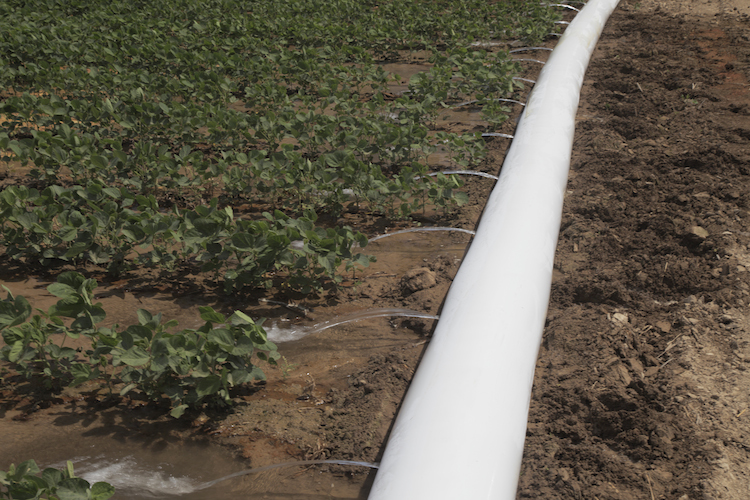
About Polytube
Although polytube is not designed to move water uphill, it has been used to move water up moderate inclines, or to go across a low area before going uphill. Use caution when transferring water up three to five feet in total elevation. It is recommended that the thicker TRANSFER polytube be used for these types of applications.
Polytube can be used to move water great distances. The maximum distance polytube can move water depends on the flow rate, the field elevation along the polytube, and the polytube size and thickness. For assistance in determining the maximum distance you can run polytube contact a Delta Plastics irrigation specialist at:
irrigationspecialists@deltaplastics.com
pipeplanner@deltaplastics.com
Delta Plastics Tri-Ply Polytube is created using cutting-edge technology and is available in various mil thicknesses. Our process bonds three layers of polytube together, producing a tougher, more flexible polytube structure. This exclusive bonding process makes Tri-Ply Polytube as strong as higher-mil polytube and more economical than lower mils. For more information, call 800-277-9172.
The polytube size and thickness needed depends on the flow rate, polytube length, and the acres irrigated. Generally farmers use a roll (1,320 ft.) of 15″ polytube for 1,200-2,000 gallons of water per minute to be moved through the pipe irrigating an area around 20-40 acres. For more on polytube sizes and flow capacity.
 Characteristics Flow Capacity (GPM) (220 KB)
Characteristics Flow Capacity (GPM) (220 KB)
Installation and Troubleshooting:
Polytube can work with diesel, natural gas, propane, and even electric-powered pumps. Polytube installation is generally easier when the pump’s flow rate can be varied. More caution is usually needed with electric-powered pumps unless they are variable-speed design.
Yes, a vacuum breaker/air vent must be provided at the polytube connection point to prevent the polytube from being sucked back into the pipe when pumping stops. A temporary solution can be achieved by installing a 2 ½″-diameter Blumhardt gate in the top of the polytube where it connects to solid pipe and opening the gate before pumping stops. This should be replaced with a vacuum breaker/air vent as soon as possible to provide protection if the pump shuts down by itself.
For general information on GPM and CFM flow rates for different hole sizes, click on link:
 Flow Estimates for Holes - (GPM) (442 KB)
Flow Estimates for Holes - (GPM) (442 KB)
 Flow Estimates for Holes - (CFM) (429 KB)
Flow Estimates for Holes - (CFM) (429 KB)
Delta Plastics also offers a tool called Pipe Planner which assists in determining the most efficient hole size. Learn more at www.pipeplanner.com.
At each air pocket, poke a hole no larger than 1/8″ at the high noon position of the polytube. A small object like a nail is recommended for puncturing. Never use a knife! View this short informative video to learn more: http://www.youtube.com/watch?v=jHzg9fQEYkM
It is generally suggested to use barrels or chokes at about every 0.4 ft. (4 to 5 inches) of elevation drop along the polytube.
Pipe Planner is an extremely powerful resource for assisting the user in determining the most efficient way to irrigate an area. The potential of the program to produce valid designs is directly affected by the accuracy of the data given by the user.
Increased Savings
- 25% average reduction in water usage
- 25% average reduction in associated energy costs
- Labor cost is reduced
More Accurate Planning
- Determines best polytube size
- Details field layout for polytube
- Provides hole sizes and location details
Improved Efficiency
- Distributes water evenly down furrows
- Improves irrigation efficiency
- Reduces excessive water runoff
Learn more here >
The splicer should be the same size as the diameter of the polytube being used.
Tying off polytube is not recommended. The end of the polytube should be left open while it is being filled with water so that air and excess water flow can be released. After holes or gates have been installed, it is still recommended to leave the end of the polytube open lying over a barrel, wooden pallet, mound of dirt, etc. to allow for air and excess pressure relief.
Gates are usually installed at the 12 to 3 position on polytube used in rice fields. Location of gates in the polytube between levees depends somewhat on farmer preference, and the layout in the field. For specific field recommendations please contact one of our irrigation specialists at irrigationspecialists@deltaplastics.com
Common reasons for these problems can be caused by, but are not limited to, the following:
- Polytube is too small for pumping conditions
- Damage to the roll during handling or installation
- Polytube flapping or fluttering
- Improper installation
Learn more with Polytube Issues and Tips
 Polytube Issues & Tips (741 KB)
Polytube Issues & Tips (741 KB)
Recycling
We offer two convenient options for recycling your used polytube:
On-Farm Collection Site
Our fleet of specially equipped collection trucks and expert drivers will pick up used polytube in Arkansas, Louisiana, Mississippi, Missouri, and parts of Texas.
- We will pick up your used polytube for FREE (15-roll minimum) at your designated on-farm collection site
- Your collection site will be identified with an official sign available in several sizes
Delta Plastics Collection Site
Drop-off at any official Delta Plastics polytube collection site is FREE of charge. Prepare polytube to be recycled by rolling it tightly into rolls at least 20'' in diameter using a polytube retriever or by baling it into large squares. Rolls should be secured with rope, tape, polytube or shrink-wrap to prevent unrolling. Wood/plastic cores may be left in the center of rolls. Because of the handling costs involved in recycling polytube, we cannot accept small, loose or spaghetti-style rolls of polytube.
Contact us today at recycling@deltaplastics.com or 800.277.9172 to set up your on-farm collection site, find an official Delta Plastics collection site near you, or get more information about recycling other plastics.
Learn more at Polytube Collections & Recycling
